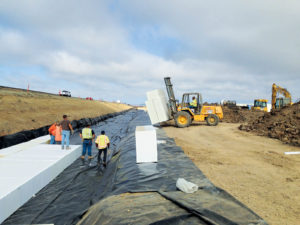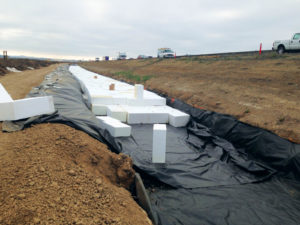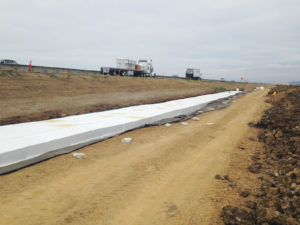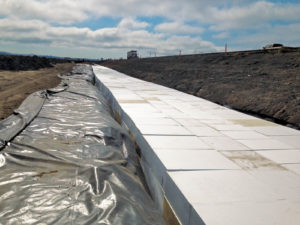
How geofoam, as lightweight structural fill, solved a variety of construction challenges on a roadway embankment project in support of wetlands restoration in Northern California
Introduction
As those in the design and construction community know well, every project is slightly different from the last regardless of how many times similar challenges have been faced. When it comes to heavy civil construction involving the ever-so-delicate restoration of a natural wetlands area, those differences can be magnified significantly by the specific soil conditions at the project site.
For Scott Ghilotti, vice president at Maggiora & Ghilotti Inc. of San Rafael, Calif., finding solutions to complex problems proves to be one of the most rewarding aspects of any project.
“Wetlands restoration projects always require strategic thinking,” said Ghilotti, a fourth-generation builder in a family-owned business. “Access to the construction area is almost always impacted by the soil conditions because of the soft and loose nature of the sediment and the volume of moisture within the dirt. Getting heavy equipment in and out really requires a detailed investigation of the changing soil conditions across the site and often some out-of-the-box thinking.”
When Ghilotti’s firm was hired to work on a wetlands levee reinforcement project 40 miles inland from San Francisco, he knew he would need to find innovative solutions, a process that often translates to discovering innovative uses of unconventional construction materials.

Roadway reinforcement
This project, known as Cullinan Ranch, is part of a multi-dimensional effort to restore more than 1,500 acres of tidal wetlands in the San Pablo Bay National Wildlife Refuge. In addition to Ghilotti’s role as general contractor, the project benefited from the expertise and professional contributions from the U.S. Fish and Wildlife Service (FWS), the California Department of Transportation (CalTrans), and Ducks Unlimited (DU), a world leader in wetlands and waterfowl conservation.
The Cullinan Ranch project involved reinforcing a roadway levee along two miles of Highway 37, which runs adjacent to the wetlands and just a few miles from San Pablo Bay. Prior to restoration, the site had been diked off from natural tides for more than 100 years and was used as oat and hay farmland for generations.

trench was lined with a gas-resistant membrane that protects the geofoam from oil and gas
contaminants in roadway runoff.
Levee integrity
To re-create a wetlands area that was naturally inviting to fowl and other wildlife, the FWS wanted to mimic the transitional zones between the wetlands and highway, which meant adding a significant volume of material to accommodate a gentle slope from the elevated levee to the wetlands.
Because of the soft soils in the area, known locally as “Bay Mud,” CalTrans initially identified two concerns:
- First, adding a significant volume of weight to the embankment (in the form of additional soil or even a lightweight concrete fill) could cause roadway settling over time, potentially damaging the levee.
- Second, a strictly soil-slope type of fill would likely be adversely affected by erosion from water washing from the highway down the hillside, eventually requiring additional soil to maintain the desired slope.
In fact, one of the most expensive aspects of this project was to protect Highway 37 from floodwaters once the wetlands’ tidal flow was restored. Thus, the integrity of the levee could not be compromised.
During the design stage, engineers from DU proposed the use of expanded polystyrene (EPS) foam (geofoam) as a structural fill because of its light weight and high compressive strength. At about 1% the weight of traditional earth materials, geofoam is a cellular plastic material with a compressive resistance up to 18.6 pounds per square inch (psi) at 1% deformation. Furthermore, geofoam is approximately 1% the weight of traditional fill, making it a good candidate for this situation.
“Geofoam was not only the quickest solution for this project, but the cost was on par with other options as well,” said Russ Lowgren, an engineer on the project with Ducks Unlimited.

Logistics and installation
With the selection of the lightweight geofoam, Ghilotti’s team was able to map out the placement and configuration of each section of fill to create the required slope grades along the entire two miles of roadway.
It was crucial for Ghilotti’s construction strategy, as a low-bid builder, to minimize the amount of wasted product during the installation process. After laying out the exact foam block configuration for each fill section, he was able to then reduce the total volume of wasted foam to less than 0.025% across the entire two-mile section.
Once the foam was cut, it was trucked to the site in a just-in-time-delivery strategy so that each section of geofoam blocks was unloaded from trucks in the exact order needed for installation. This allowed work crews to assemble the blocks in place with minimal need for site staging or protective storage.
After the embankment’s existing drainage ditch was scraped and compacted, the trench was lined with a gas-resistant membrane designed to protect the foam from potentially corrosive contaminants washing off of the road’s surface. With the protective materials in place, the foam blocks were assembled according to Ghilotti’s configurations.
In total, the project called for more than 15,000 cubic yards of EPS #29 geofoam and Ghilotti estimated his crews were able to install an average of about 1,500 yards of configured block a day.
Once each section of geofoam was in place, the sides of the gas-resistant membrane were pulled over the top and then fused closed to secure the blocks inside. The final step in creating the required slope was the one that caused Ghilotti the most concern.

“I was really worried about how the over-fill, compaction, and grading processes were going to work out,” said Ghilotti. “A roadway embankment project of that magnitude requires extremely heavy equipment, some of which is on the order of 35-plus tons when fully loaded. The idea of driving a machine weighing that much across blocks made from foam seemed impossible.”
However, the geofoam team assured him that with as little as 12–18in. of soil placed over the wrapped foam, the structure would be undamaged by the weight of even the heaviest equipment required. And they were correct.
Conclusions
Cullinan Ranch is now a vital tidal marsh full of an array of native wildlife and vegetation. It is open for public visitation as part of the remediated and restored San Pablo Bay National Wildlife Refuge.

This project restored more than 1,500 acres of tidal wetlands in the San Pablo Bay National Wildlife Refuge. Cullinan Ranch was once part of an extensive network of tidal marshes in San Francisco’s North Bay. It was diked in the late 1800s for farming until the U.S. Fish and Wildlife Service acquired the property in 1991 and incorporated it into the San Pablo Bay National Wildlife Refuge.
Subsequent restoration was delayed because of the need to protect Highway 37 from flooding associated with tidal reintroduction. But that issue was later addressed with a reinforced roadway levee to protect the highway and subdue potential erosion.
Other Cullinan Ranch project elements included protecting existing infrastructure, and breaching and lowering levees to allow sedimentation processes to restore the tidal marsh. This restoration undertaking will improve ecologic health, habitat connectivity, and water quality of the lower Napa River and San Pablo Bay.
Sean O’Keefe is principal at Sean O’Keefe Communications and Strategy based in Denver, Colo.Ron Bygness, senior editor at Geosynthetics magazine, also contributed to this article.
 TEXTILES.ORG
TEXTILES.ORG


